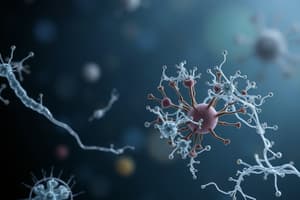Podcast
Questions and Answers
What is the highest taxonomic category in this systemization?
What is the highest taxonomic category in this systemization?
- Kingdom
- Domain
- Phylum
- Empire (correct)
What is the characteristic feature of prokaryotes?
What is the characteristic feature of prokaryotes?
- Presence of intracellular lipid-bound organelles
- Presence of a true nucleus
- Presence of membrane-bound nucleus
- Absence of membrane-bound nucleus and organelles (correct)
What is the definition of a bacterial species?
What is the definition of a bacterial species?
- A group of cells with true nucleus
- A population of cells with different characteristics
- A single cell with distinct features
- A population of cells with similar characteristics (correct)
What is the difference between Bacteria and Archaea?
What is the difference between Bacteria and Archaea?
What is the storage site of genetic information in prokaryotes?
What is the storage site of genetic information in prokaryotes?
What is the term for members of the Eukarya domain?
What is the term for members of the Eukarya domain?
What is the study of in bacterial classification?
What is the study of in bacterial classification?
What is the term used to describe the living membrane of the earth?
What is the term used to describe the living membrane of the earth?
What is the term used to describe a group of the same species of microorganisms in the same biotope?
What is the term used to describe a group of the same species of microorganisms in the same biotope?
What type of relationship between microorganisms is characterized by one organism continuing the process caused by another organism?
What type of relationship between microorganisms is characterized by one organism continuing the process caused by another organism?
What is the term used to describe an intimate, mutually beneficial relationship between organisms of different species?
What is the term used to describe an intimate, mutually beneficial relationship between organisms of different species?
What is the term used to describe a limited area of the biosphere with relatively constant conditions?
What is the term used to describe a limited area of the biosphere with relatively constant conditions?
What is the term used to describe the community of plants and animals living in a part of the habitat with more or less homogeneous conditions of life?
What is the term used to describe the community of plants and animals living in a part of the habitat with more or less homogeneous conditions of life?
What is the term used to describe the combination of biotop and biocoenosis?
What is the term used to describe the combination of biotop and biocoenosis?
What is the study of the relationship between microorganisms and their environment called?
What is the study of the relationship between microorganisms and their environment called?
What was the significance of Ivanovsky's discovery in the field of microbiology?
What was the significance of Ivanovsky's discovery in the field of microbiology?
What is the term for the study of the classification, identification, and naming of microorganisms?
What is the term for the study of the classification, identification, and naming of microorganisms?
What is the characteristic of microbial morphology?
What is the characteristic of microbial morphology?
What are the three components of bacterial taxonomy?
What are the three components of bacterial taxonomy?
What is the basis of contemporary classification of microorganisms?
What is the basis of contemporary classification of microorganisms?
In which stage of microbiology was the development of virology prominent?
In which stage of microbiology was the development of virology prominent?
Who developed the classification of microorganisms that was accepted in 1974?
Who developed the classification of microorganisms that was accepted in 1974?
What is the term for the naming of units in bacterial taxonomy?
What is the term for the naming of units in bacterial taxonomy?
Study Notes
Taxonomic Categories
- The highest taxonomic categories are Empire and Kingdom
- The three domains of life are Bacteria, Archaea, and Eukarya
- Each domain shares properties of their cells that distinguish them from members of the other domains
Characteristics of Bacteria and Archaea
- Both are single-celled organisms that do not contain a membrane-bound nucleus or other intracellular lipid-bound organelles
- Their genetic information is stored in deoxyribonucleic acid (DNA) in a region called the nucleoid
- They have a rigid cell wall and are termed prokaryotes, meaning "prenucleus"
Characteristics of Eukarya
- Termed eukaryotes, meaning "true nucleus"
- Distinctly different from members of Bacteria and Archaea
Taxonomic Categories of Classification
- Kingdom is divided into division, class, order, family, genus, and species
- Species is the lowest taxonomic category and the standard taxonomical unit in biology
- A bacterial species is defined as a population of cells with similar characteristics
Development of Microbiology
- The stages of development of microbiology are:
Morphological Stage (XVII-XIX century)
Physiological Stage (XIX-XX century)
Immunological and Development of Virology (XX century)
Modern - Molecular-Genetic Stage (XX-XXI century)
Bacterial Taxonomy
- Comprises three components: classification, identification, and nomenclature
- Classification is based on phenotypic properties: morphological, physiological, and biochemical
Ecology
- The relationship of microorganisms with the environment
- Microorganisms have a remarkable ability to adapt themselves to certain environmental conditions
- Ecological categories include:
Biosphere: the living membrane of the earth
Biotop: a limited area of the biosphere with relatively constant conditions
Population: a group of the same species of microorganisms in the same biotope
Ecosystem: biotop and biocoenosis together form ecosystem
Relationships Among Microbes
- Various groups of microbes have relationships such as:
Symbiosis: intimate mutually beneficial relationship between organisms of different species
Metabiosis: one organism continues the process caused by another organism, liberating it from the products of life activities
Studying That Suits You
Use AI to generate personalized quizzes and flashcards to suit your learning preferences.
Description
This quiz covers the classification of microorganisms into three major domains: Bacteria, Archaea, and Eukarya, and their distinct cell properties. Test your understanding of the highest taxonomic categories in microbiology.




